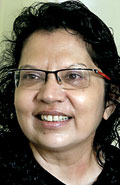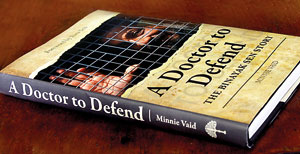In the years since his arrest, Dr. Binayak Sen has won himself thousands of supporters, including the likes of Amartya Sen and Noam Chomsky. But perhaps the most determined among them has been a documentary film maker and journalist, Minnie Vaid. Minnie, who first heard of Dr. Binayak’s case in 2007, subsequently quit her job to write a book and make a film in his defence. Someone had to – having spent years in and out of jail, Dr. Binayak has even taken his case as high as the Supreme Court of India. In the meantime, his story remains a window into what has been dubbed ‘India’s hidden war’ – many thousands have died in the naxalite conflict since it first began and today with an ever increasing number of Indian states affected, it remains a charged issue for the country. In Sri Lanka recently to launch a Sinhala translation of her book ‘A Doctor to Defend,’ Minnie says she believes Binayak’s story is equally relevant to local audiences.
 |
| Minnie Vaid. Pix by M.A. Pushpa Kumara |
A qualified paediatrician and public health specialist, Dr. Binayak has spent much of his professional career finding ways to bring aid to the poor and the underprivileged. Working in the central Indian state of Chhattisgarh – known not only for its thick forests and large tribal population but for its cases of malnutrition, tuberculosis, and a particularly virulent strain of malaria - he would run clinics that were for many their only access to medical aid. For the doctor who had graduated with a gold medal from the renowned Christian Medical College (CMC) in Vellore, there were certainly other options, but Dr. Binayak decided to add a degree in social medicine from JNU, Delhi, to his qualifications before moving to Chhattisgarh in 1981.
There, collaborating with the late Shankar Guha Niyogi, a prominent mine workers’ unionist, he helped set up the Shaheed Hospital at Dallirajhara. The hospital would be funded by the workers themselves. Later, he worked at the Mission Hospital in Tilda, and then, in 1990, he and his wife Ilina, founded ‘Rupantar,’ an NGO devoted to training village health workers and running mobile clinics. Their work won them many accolades, including the 2004 Paul Harrison Award from CMC itself, in which his Alma mater honoured him for having “redefined the possible role of the doctor in a broken and unjust society, holding the cause much more precious than personal safety.”
During this period, the couple even served as government consultants on public health related issues, says Minnie. She explains that it was only once Dr. Binayak began questioning government sponsored human rights violations that he became an enemy of the state - most notably when his NGO collaborated with four other organisations to publish a controversial report titled ‘When the State makes War against its own People.’ A year later, he was arrested on what were apparently unsubstantiated accusations of sedition, criminal conspiracy, making war against the nation, and knowingly using the proceeds of terrorism.
When Minnie first heard of Dr. Binayak’s plight, she was still working as the Creative Head of the feature film department in a Mumbai-based production company. She wanted to get involved at once but it took her a year to extricate herself. When she eventually found herself marching with hundreds of others protesting Dr. Binayak’s imprisonment, she knew she was hooked. “There were people from all walks of life there,” she says, noting that many were Dr. Binayak’s patients who had travelled great distances on foot to be present. However, Minnie would have no access to the man himself, until he was temporarily released on bail.
She describes their first meeting as almost “anti-climatic.” Dr. Binayak had no interest in claiming the title of ‘hero’ that Minnie wished to bestow on him, instead she found a very simple, direct man. What he was willing to give her were a list of names of people he had worked with over the years. For the film maker, these conversations were a tour of the underbelly of Indian development and a glimpse of what it meant to live in a state writhing in the grip of a Naxalite uprising.
Minnie scoffs at Prime Minister Manmohan Singh’s oft quoted condemnation of the movement as “the single biggest internal security challenge ever faced by our country.” “Once you know these people and have lived with them it isn’t the same,” she says, conceding however that incredible violence that so characterizes the movement dismays her as much as it does Dr. Binayak.
 |
With the movement’s various factions, its long history and its different character in each state, it does not easily lend itself to neat summaries. Suffice to say, the Naxal movement, taken from the name of the Naxalbari district in West Bengal where it first began in 1967, is a revolutionary movement fuelled by an uprising among landless workers protesting centuries of exploitation by the upper classes and state. Radical communists, they embrace Maoist politics and claim to represent the poorest of the poor. In Indian states such as Orissa, Chhattisgarh and Jharkhand where the movement is particularly strong, impoverished tribal people living on mineral rich land come into direct conflict with the powers that be, losing land, rights to the forest and being routinely displaced by mining and hydroelectricity operations.
However, with the movement having brutally executed a string of landowners, policemen, forest rangers and many others including innocent civilians, they have been labelled terrorists.
The government has responded with terrible repression, cracking down on any critics with an iron fist and in some instances, arming widely loathed paramilitary groups who destroy entire villages with impunity, raping and looting as they go. Included among the former have been intellectuals, journalists and students, and of course activists like Dr. Binayak. “The government clearly wanted to make an example of him,” says Minnie, she has no doubts that his treatment will discourage others who would criticise the state’s handling of the situation.
Currently, Dr. Binayak is out of jail and in between hearings, and it is possible that he might find himself once more imprisoned. However, like many of his other supporters, Minnie hopes that he will have justice in the end. She admires him particularly because the doctor could have chosen differently, but instead stood by his principles at great personal cost to himself and his family.
She is drawn to such individuals and says she’s already at work on another book due out next year about the woman dubbed the ‘Iron Lady of Manipur’. Irom Sharmila Chanu holds records for going on the world’s longest hunger strike in protest against the draconian Armed Forces (Special Powers) Act of 1958 that allows the military complete leeway in handling “disturbed areas” such as Irom’s home state of Manipur. She is fed through a tube, not having voluntarily consumed anything for more than 500 weeks. Though she is moving on, in a sense, Dr. Binayak, will remain one of Minnie’s personal heroes. “I salute people like him who have the guts to stand by their convictions,” she says. |



